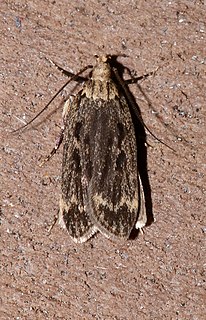Helcystogramma rhabduchum is a moth in the family Gelechiidae. It was described by Edward Meyrick in 1911. It is found in Sri Lanka and India.
Helcystogramma pantheropa is a moth in the family Gelechiidae. It was described by Edward Meyrick in 1913. It is found in South Africa.
Dichomeris corniculata is a moth in the family Gelechiidae. It was described by Edward Meyrick in 1913. It is found in Assam, India and Guangdong, China.
Hypatima euplecta is a species of moth in the family Gelechiidae. It was described by Edward Meyrick in 1904. It is found in Australia, where it has been recorded from Queensland, New South Wales, Victoria and South Australia.
Ardozyga haemaspila is a species of moth in the family Gelechiidae. It was described by Oswald Bertram Lower in 1894. It is found in Australia, where it has been recorded from New South Wales and South Australia.
Parapsectris tholaea is a moth in the family Gelechiidae. It was described by Edward Meyrick in 1911. It is found in South Africa, Namibia and Zimbabwe.
Idiophantis chiridota is a moth of the family Gelechiidae. It was described by Edward Meyrick in 1914. It is found in Sri Lanka, Thailand, on the Sunda Islands and Fiji.
Aristotelia saturnina is a moth of the family Gelechiidae. It was described by Edward Meyrick in 1917. It is found in Peru.
Photodotis prochalina is a moth of the family Gelechiidae. It was described by Edward Meyrick in 1911. It is found in South Africa.
Autosticha vicularis is a moth in the family Autostichidae. It was described by Edward Meyrick in 1911. It is found in Sri Lanka.
Antaeotricha sparganota is a moth of the family Depressariidae first described by Edward Meyrick in 1915. It is found in Guyana.
Antaeotricha corvigera is a moth of the family Depressariidae first described by Edward Meyrick in 1915. It is found in Guyana and Peru.
Carodista geraea is a moth in the family Lecithoceridae. It was described by Edward Meyrick in 1911. It is found in Sri Lanka.
Lecithocera compsophila is a moth in the family Lecithoceridae. It was described by Edward Meyrick in 1911. It is found in Sri Lanka.
Lecithocera fornacalis is a moth in the family Lecithoceridae. It was described by Edward Meyrick in 1911. It is found in Sri Lanka.
Deltoplastis byssina is a moth in the family Lecithoceridae. It was described by Edward Meyrick in 1910. It is found in Sri Lanka.

Martyringa xeraula, the Himalayan grain moth, is a moth in the family Lecithoceridae. It was described by Edward Meyrick in 1910. It is found in India (Assam), western China, Japan and North America, where it has been recorded from Louisiana, Texas and from Florida to South Carolina.
Phatnotis factiosa is a moth in the family Lecithoceridae. It was described by Edward Meyrick in 1913. It is found in southern India.
Imma thyriditis is a moth in the family Immidae. It was described by Edward Meyrick in 1906. It is found on the Solomon Islands.

Tingena eumenopa is a species of moth in the family Oecophoridae. It is endemic to New Zealand and found in the North and South Islands. The adults have been found amongst tree ferns and are on the wing in December.

